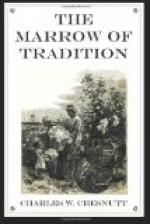The car was conspicuously labeled at either end with large cards, similar to those in the other car, except that they bore the word “Colored” in black letters upon a white background. The author of this piece of legislation had contrived, with an ingenuity worthy of a better cause, that not merely should the passengers be separated by the color line, but that the reason for this division should be kept constantly in mind. Lest a white man should forget that he was white,—not a very likely contingency,—these cards would keep him constantly admonished of the fact; should a colored person endeavor, for a moment, to lose sight of his disability, these staring signs would remind him continually that between him and the rest of mankind not of his own color, there was by law a great gulf fixed.
Having composed himself, Miller had opened a newspaper, and was deep in an editorial which set forth in glowing language the inestimable advantages which would follow to certain recently acquired islands by the introduction of American liberty, when the rear door of the car opened to give entrance to Captain George McBane, who took a seat near the door and lit a cigar. Miller knew him quite well by sight and by reputation, and detested him as heartily. He represented the aggressive, offensive element among the white people of the New South, who made it hard for a negro to maintain his self-respect or to enjoy even the rights conceded to colored men by Southern laws. McBane had undoubtedly identified him to the conductor in the other car. Miller had no desire to thrust himself upon the society of white people, which, indeed, to one who had traveled so much and so far, was no novelty; but he very naturally resented being at this late day—the law had been in operation only a few months—branded and tagged and set apart from the rest of mankind upon the public highways, like an unclean thing. Nevertheless, he preferred even this to the exclusive society of Captain George McBane.
“Porter,” he demanded of the colored train attache who passed through the car a moment later, “is this a smoking car for white men?”
“No, suh,” replied the porter, “but they comes in here sometimes, when they ain’ no cullud ladies on the kyar.”
“Well, I have paid first-class fare, and I object to that man’s smoking in here. You tell him to go out.”
“I’ll tell the conductor, suh,” returned the porter in a low tone. “I ‘d jus’ as soon talk ter the devil as ter that man.”
The white man had spread himself over two seats, and was smoking vigorously, from time to time spitting carelessly in the aisle, when the conductor entered the compartment.
“Captain,” said Miller, “this car is plainly marked ‘Colored.’ I have paid first-class fare, and I object to riding in a smoking car.”
“All right,” returned the conductor, frowning irritably. “I’ll speak to him.”
He walked over to the white passenger, with whom he was evidently acquainted, since he addressed him by name.




